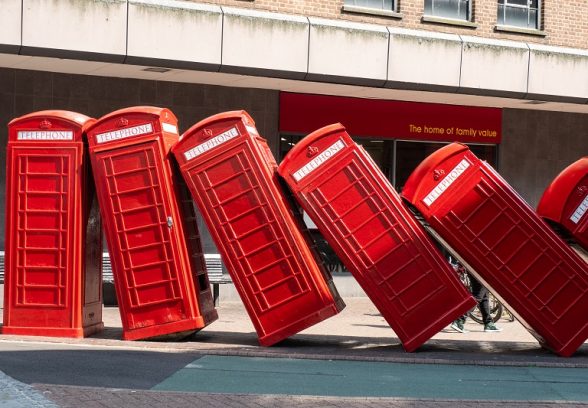This website uses cookies
This website uses cookies to enable it to function properly and to analyse how the website is used. Please click 'Close' to accept and continue using the website.



19. K2 & K6; 20. K6 Red Telephone Boxes
Status: Listed Grade II
Architect: Sir Giles Gilbert Scott (K2 & K6), Bruce Martin (K8)
In 1912 the General Post Office took over control of almost all of the national telephone network and in 1921 developed a prototype telephone box, K1. The design was not a success with some councils refusing to have them in their boroughs (Eastbourne only relented when they were allowed to give theirs thatched roofs).
In 1924 the Royal Fine Art Commission launched a competition for a new design, which was won by Sir Giles Gilbert Scott, who was fresh from his success with the Anglican Cathedral in Liverpool. Scott’s original colour for the K2 was silver, but the Post Office changed this to red. The K2 was a huge critical success and led to Scott being commissioned to design further variations which could be installed nationwide. The most popular and most common was the smaller more cost effective K6 which Scott designed in 1935 to coincide with the Jubilee of King George V with many thousands being installed across the country. The K8, introduced in 1968 and designed by the architect Bruce Martin, was the last in the line of the iconic red telephone boxes.
With the privatisation of British Telecom in 1984, a multi-million pound modernisation programme of the payphone network was announced, which proposed ripping out all the existing red boxes and replacing them with cheaper, poorer quality versions, partly on grounds of function, but chiefly to create a new image.
The C20 Society launched a vigorous campaign, writing to every local authority alerting them to the threat of losing these much-loved objects which were already regarded as visible symbols of Britain as well as being one of the finest examples of British industrial design. The Department of the Environment had declined to make a small change to conservation legislation to encompass street furniture so the only solution to safeguard the boxes was for C20 to press for the statutory listing of kiosks as ‘miniature buildings’ which was achieved in 1986 with the listing of a rare example of a K3 box at London Zoo. Thanks to C20’s sustained efforts, many more listings followed. The K6 could not be listed unless it could be demonstrated that they had been installed before 1939. In 1987 this arbitrary end date for listing was replaced by the “thirty-year rule”. It is thought that only around 60 K8s have survived and some of these too have also being recognised with protected listing status, thanks to another concerted campaign by C20.
It is thought that around 3,000 phone boxes have been designated as Grade II-listed buildings. Many have been repurposed as libraries, coffee kiosks, workshops, art installations and to house defibrillators, once again fulfilling an important role in the community and demonstrating the importance and longevity of good design.
Browse the list of the 40 buildings or search for individual buildings or architects.

Become a C20 member today and help save our modern design heritage.